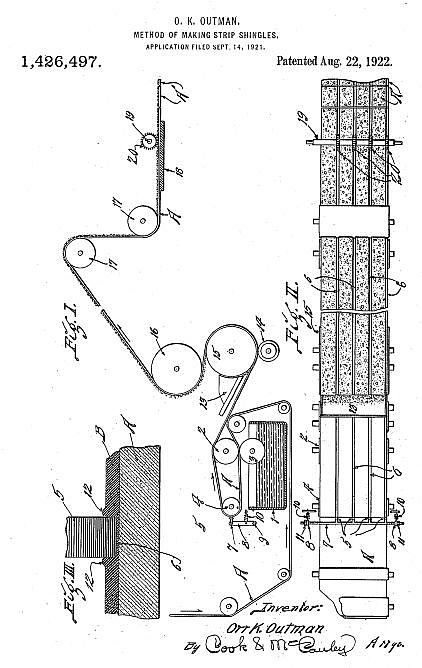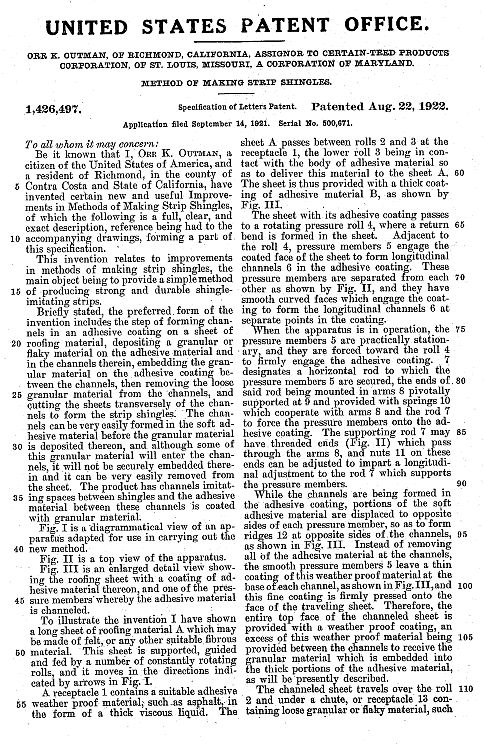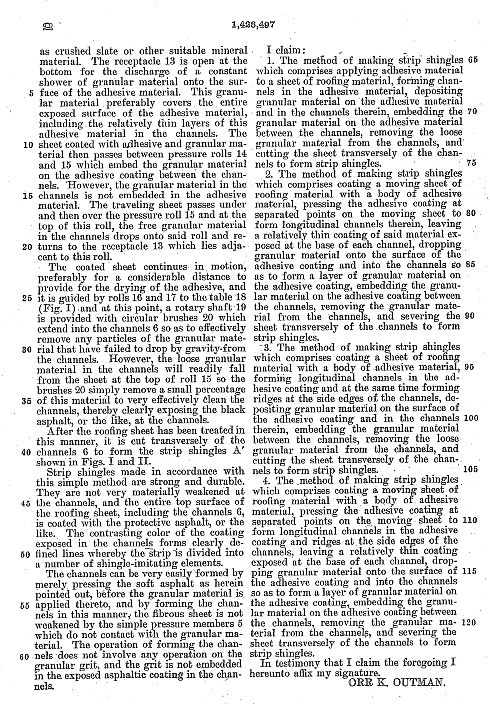| Starting in the early 1900's, several of the Illinois Outman's, including William Henry Outman and his sons Orr, Winifred, and Leslie, worked for the Certain-Teed roofing company, both in Illinois and California. In September 1921 Orr K. Outman applied for a U. S. Patent for a method of making roofing shingles. This patent was issued in August 1922. (Winfred was later issued 2 of his own shingle-related patents.) Several years after this, Orr was sued in Patent Court by a Mr. William Hofman who claimed to have invented that type of shingle before Orr's patent. The case was found in favor of Orr Outman. Hofman then appealed the decision and lost again. Below is Orr's patent and the record of the Appeals Court decision: |
Page 1:
|
Page 2:
|
Page 3:
|
Appeals Court decision in Hofman v. Outman:
|
Page 280 v. OUTMAN. Appeal from Decision of Commissioner of Patents. Patent interference proceeding between William T. Hofman and Orr K. Outman. From a decision of the Commissioner of Patents, awarding priority to Outman, Hoffman appeals. Affirmed. M. B. May, of Boston, Mass., for appellant. H. D. Spencer, of New York City, for appellee. Before MARTIN, Chief Justice, and ROBB and VAN ORSDEL, Associate Justices. ROBB, Associate Justice. Appeal from a decision of the Commissioner of Patents, in an interference proceeding, awarding priority to the senior party and patentee, Outman. The Outman application was filed September 14, 1922, and the patent issued August 22, 1922. As Hofman did not file his application until February 2, 1923, or about five months after the grant of the Outman patent, the burden is on him to establish his case beyond a reasonable doubt. The invention is a method of making mineral-surfaced strips of shingles having parallel grooves or channels perpendicular to the long edges, in which grooves the asphalt is so exposed that, when laid on the roof in overlapping relation, the effect is that of spaced individual shingles. The evidence for Outman clearly establishes conception and disclosure of the invention early in April of 1920, and commercial manufacture early in 1921. Hofman, in his preliminary statement, alleged conception, disclosure and reduction to practice of the invention in September of 1919, and "that the invention has been practiced on a considerable scale continuously, since its conception." No testimony whatever was introduced to establish these dates. There was evidence, however, tending to show a reduction to practice on December 22, 1920. While this evidence was satisfactory to the Examiner of Interferences, it did not satisfy the Board or the Commissioner. The board found that the story as to the manner of making Exhibit No. 1 was improbable, and that Hofman's evidence was too conflicting to sustain the heavy burden upon him. The Commissioner again reviewed the evidence and said: "The Examiners in Chief in their decision noted a number of inconsistencies in the testimony submitted in behalf of Hofman, which will not be repeated herein, except as to the inconsistency that exists between Hofman's preliminary statement, which is supposed to have been prepared with the utmost care, and Hofman's testimony." Later in his decision the Commissioner observed: "The roll of roofing (Hofman's Exhibit No. 1) has every appearance of being a finished commercial product, and not an experimental product, produced in the crude manner explained by the witnesses." The Commissioner further directed attention to the fact that the delay in filing the Hofman application had not been satisfactorily explained, nor had Hofman satisfactorily shown why, after his claimed reduction to practice, "he suddenly lapsed into a state of inactivity, and rested more than two years before filing his application." A careful reading of the record convinces us that the conclusion reached by the upper tribunals of the Patent Office was correct, and, for the reasons more fully stated by them, the decision is affirmed. Affirmed. |